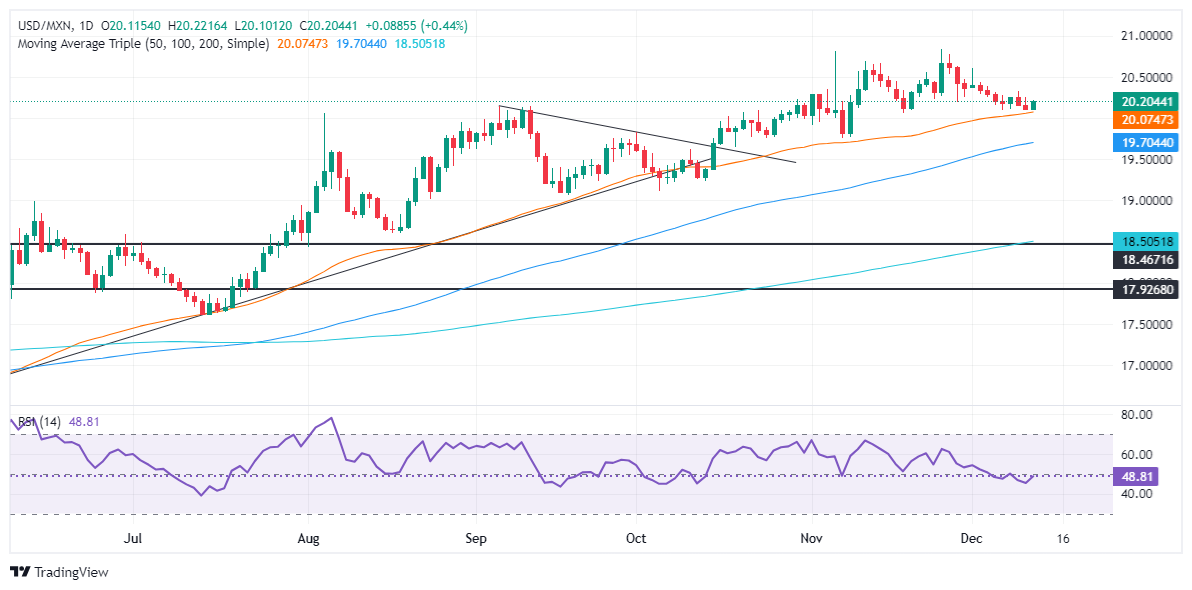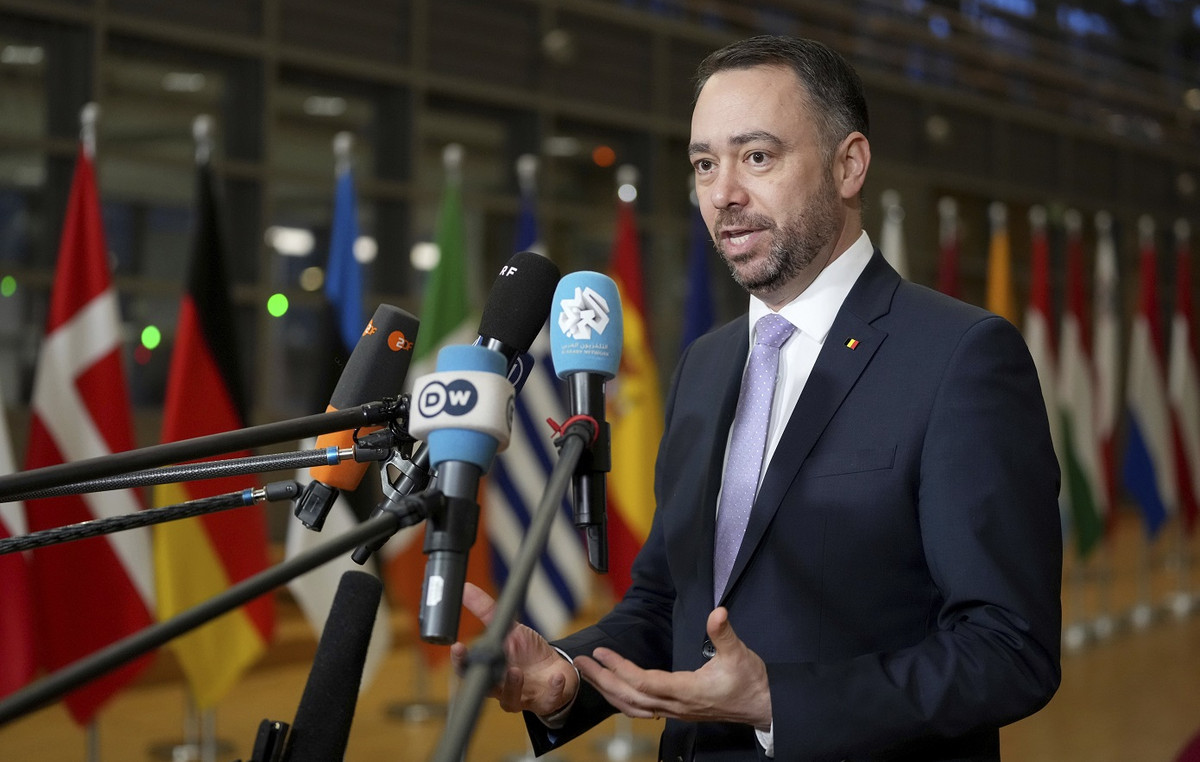- Mexican Peso Depreciates, Reversing Weekly Gains Amid Mixed US Economic Reports
- The US Producer Price Index rises to the highest level since June, fueling discussions about inflationary trends.
- The Fed is expected to cut interest rates by 25 basis points next week.
The Mexican Peso weakens after posting two consecutive days of gains, falling more than 0.44% against the US Dollar, as mixed US economic data and a holiday in Mexico keep trading conditions subdued. USD/MXN is trading at 20.20 after bouncing from weekly lows of 20.09.
Inflation in US factories rose in November, according to the US Bureau of Labor Statistics. The Producer Price Index (PPI) rose to its highest level since June, according to monthly figures. At the same time, the Labor Department reported that Americans filing for unemployment benefits had increased.
Even though inflation has picked up, market participants seem confident that the Federal Reserve (Fed) will cut interest rates at next week’s meeting. The odds of the Fed cutting rates by 25 basis points are now 99%, according to the federal funds rate futures market.
Mexico’s economic agenda revealed that Industrial Production plummeted in October, both in monthly and annual figures.
On Wednesday, the Bank of Mexico (Banxico) remained confident in the country’s financial system despite the “notable weakness” experienced by Latin America’s second-largest economy. In the biannual report, Banxico recognized the robust institutions for the stability of the system, adding that capital and liquidity levels are above regulatory minimums.
Aside from this, Banxico is expected to continue its easing cycle following Monday’s inflation report. The Consumer Price Index (CPI) for November opened the door to greater flexibility. JP Morgan analysts noted that Banxico could cut rates by 50 basis points (bps) as inflation data shows prices are falling faster than expected.
The economic agenda for the rest of the week is empty in Mexico. In the US, it will include Import and Export Prices.
Daily Market Summary: Mexican Peso on Defensive After High US PPI
- The November PPI showed that headline inflation rose to 3% year-on-year, up from 2.4% in October and above the expected 2.6%. The core PPI also rose to 3.4% year-on-year, beating forecasts of 3.2% and 3.1% in October.
- Initial US jobless claims for the week ending December 7 rose to a two-month high of 242,000, well above the projected 220,000.
- Mexico’s Industrial Production contracted -1.2% monthly in October, compared to an expansion of 0.6% in September and well below estimates of -0.2%. On an annual basis, production fell -2.2% year-on-year from -0.3%, missing forecasts of -0.6%.
- The swaps market suggests that Banxico will cut interest rates by 25 basis points at the December 19 meeting.
- The 2025 US yield curve suggests speculators estimate 100 basis point easing by the end of the year.
- Data from the Chicago Board of Trade, via the December federal funds rate futures contract, shows that investors are estimating a 24 bp easing by the Fed by the end of 2024.
- The governor of Banxico, Victoria Rodríguez Ceja, remains moderate. In his latest interview with Reuters, he said that given the progress of disinflation, the central bank could continue to reduce borrowing costs.
USD/MXN Technical Outlook: Mexican Peso Wobbles as Pair Jumps to 20.20
USD/MXN rebounds from weekly lows as the exotic pair consolidated below the 20.10 area over the past four days. However, demand for US Dollars weighed on the Peso and lifted the pair back to the 20.20 mark.
Momentum remains tilted to the downside, as shown by the Relative Strength Index (RSI). But sellers must push USD/MXN below 20.00, which will clear the way for lower exchange rates.
In that case, the next support for USD/MXN would be the 100-day SMA at 19.68, ahead of 19.50. On further weakness, the pair could test the October 4 low of 19.10, before 19.00.
On the contrary, if buyers hold USD/MXN above 20.20, the next resistance would be 20.50. A break of the latter will expose the December 2 daily high of 20.59, followed by the yearly high of 20.82, followed by the 21.00 mark.
The Mexican Peso FAQs
The Mexican Peso (MXN) is the most traded currency among its Latin American peers. Its value is largely determined by the performance of the Mexican economy, the policy of the country’s central bank, the amount of foreign investment in the country and even the levels of remittances sent by Mexicans living abroad, particularly in the United States. . Geopolitical trends can also affect the MXN: for example, the nearshoring process (or the decision by some companies to relocate manufacturing capacity and supply chains closer to their home countries) is also seen as a catalyst for the currency. Mexican, as the country is considered a key manufacturing center on the American continent. Another catalyst for the MXN is oil prices, as Mexico is a key exporter of the raw material.
The main objective of Mexico’s central bank, also known as Banxico, is to keep inflation at low and stable levels (at or near its target of 3%, the midpoint of a tolerance band between 2% and 4%. %). To do this, the bank establishes an appropriate level of interest rates. When inflation is too high, Banxico will try to control it by raising interest rates, which makes borrowing more expensive for households and businesses, thus cooling demand and the economy in general. Higher interest rates are generally positive for the Mexican Peso (MXN) as they lead to higher yields, making the country a more attractive place for investors. On the contrary, lower interest rates tend to weaken the MXN.
The publication of macroeconomic data is key to evaluating the state of the economy and can have an impact on the valuation of the Mexican peso (MXN). A strong Mexican economy, based on high economic growth, low unemployment and high confidence is good for the MXN. Not only does it attract more foreign investment, but it may encourage the Bank of Mexico (Banxico) to raise interest rates, particularly if this strength is accompanied by high inflation. However, if economic data is weak, the MXN is likely to depreciate.
As an emerging market currency, the Mexican Peso (MXN) tends to rise during periods of risk, or when investors perceive overall market risks to be low and are therefore eager to engage in investments that carry higher risk. . Conversely, the MXN tends to weaken in times of market turbulence or economic uncertainty, as investors tend to sell riskier assets and flee to more stable safe havens.
Source: Fx Street
I am Joshua Winder, a senior-level journalist and editor at World Stock Market. I specialize in covering news related to the stock market and economic trends. With more than 8 years of experience in this field, I have become an expert in financial reporting.








